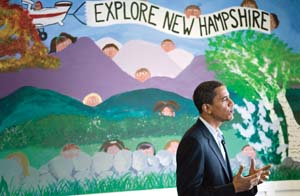Obama Photos: NH Campaign Trail
SLIDE SHOW: Tim Llewellyn photos of Obama campaign in New Hampshire VIDEO: Tim Llewellyn’s interview on Maine’s TV news magazine “207”. I remember sitting in my American history class in school, glazing over at the names and dates, never internalizing the fact that both belonged to real flesh-and-blood people. So much mythology surrounded these figures […]

Barack Obama responds to questions during an interview with New Hampshire’s WMUR-TV at Concord Municipal Airport in March 2007.
Photo Credit : Llewellyn, TimSLIDE SHOW: Tim Llewellyn photos of Obama campaign in New Hampshire
VIDEO: Tim Llewellyn’s interview on Maine’s TV news magazine “207”.
I remember sitting in my American history class in school, glazing over at the names and dates, never internalizing the fact that both belonged to real flesh-and-blood people. So much mythology surrounded these figures that Washington and Jefferson were no more concrete to me than Jay Gatsby, just as Julius Caesar was no more real than Aeneas–and often less.
Looking back, the most important day in my study of history came on a cold morning in New Hampshire, more than a decade after I’d sat in those classrooms. It was the day I was standing next to the slender senator from Illinois, listening to a pulsing crowd.
I spent the better part of a year working as Senator Barack Obama’s personal campaign photographer. I traveled around New Hampshire with him, documenting his road to the White House. From the motorcade to the town hall meetings, from Manchester to Berlin, I witnessed firsthand the campaign’s transformation from a small grassroots operation into an international phenomenon. And as his photographer, I’m pretty sure I had the best seat in the house.
I was with him when he signed the official registry as a candidate in the nation’s first primary, I was with him when the crowds started to line up around the block to hear him speak, I was there as rooms overflowed with the crowd, and I was there when he gave his now-historic “Yes We Can” speech in Nashua.
I know that I was a part of history, or at least got to stand onstage as it unfolded. But these stuff-of-history moments aren’t as important to me as the small ones. It was in the details that I began to see history in a different way.
The question I most often get when I talk to people about my time with the candidate is: “Is he the real thing?” They want to know what he’s like as a person. This is how I answer. A few months into the campaign, my father’s brother died; he’d been living with my family as he battled late-stage liver cancer. When he passed away, I missed some campaign time to be with my family. After the funeral, we were all sitting around the dinner table when my phone rang; not wanting to answer, I let the call go to voice mail. Later I found the call had come from Senator Obama, giving his condolences to my family. He told me to take as much time as I needed and that his thoughts were with my family during those difficult days.
That phone call, less than a minute, defined my time with the senator. It was unexpected and perhaps unnecessary, but it was heartfelt and spoke to the core of my time with him. And my father, who had voted Republican in an uninterrupted streak that ran for 50 years, voted for a Democrat last November.
It was moments like this, and moments smaller, that I’ll never forget. Playing basketball with him in a high-school gym before a rally, watching a college football game with the staff, or sitting in a hotel room telling him about my fiancé … Those moments taught me about the quality of the man–not as a politician, a campaigner, or now a president, but as a person.
So I answer that question, “Yes, he’s the real thing.”
At these campaign events, I often saw Ken Burns, the filmmaker who has chronicled the span of American history, from Lewis and Clark to the Civil War to jazz to World War II. I’d think how interesting this campaign must be through his eyes, to know that he was watching the next chapter of American history as it crisscrossed his home state. His documentary on the Civil War shows a photograph of Lincoln walking off the stage after delivering the Gettysburg Address; the photographer had missed a shot of the speech because of its brevity. I think of that photographer, now long dead, who witnessed history through his lens and most likely at the time didn’t realize how momentous an event he had just documented. I’m perhaps not too unlike him. But I tried to keep in the front of my mind, at every speech and every stop along the road, how important it was for me to document this very real man’s campaign for the White House.
And then, almost a year later, I stood in my voting booth casting my ballot for the senator for whom I’d worked and had so much respect–and I felt the myth creeping back in–as though the full weight of American history were leaning upon him, forcing him to face these uncertain times as more than himself, as next in a line of iconic American presidents, stretching back into the fog of our collective heroic mythology.
But I can look back at a photograph I have of the senator and myself that was taken in Nashua, and I feel confident that in whatever direction we need to go as a country, he’ll take us there with compassion and humanity. And I can rest easier knowing, firsthand, that he’s the real thing.
SLIDE SHOW: More of Tim Llewellyn’s photos of the Obama campaign in New Hampshire


